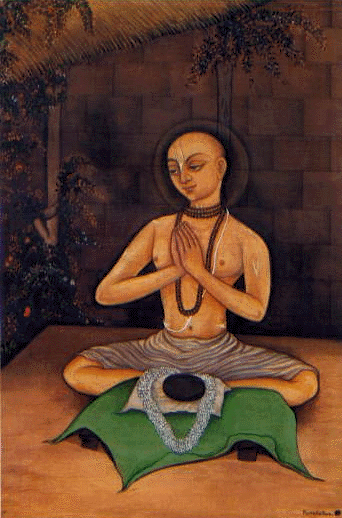by Shrila Gopala Bhatta Gosvami
APPENDIX II
Add Vishnu smaranam and details on sankalpa (names of the years, nakshatras etc.)
The Common Rites (Continued)
Vasudhara
One should draw with sindhura on the East or North wall (in the room in which the puja is being performed) of the building a half moon, a triangle (with the point at the top), and a svastika.
Under these drawings make seven dots with the sindhura starting from left to right. The drawings should be on the same level as one’s navel. Taking a piece of kusha grass with the tip dipped in ghee, touch each dot so that the ghee runs down the wall towards the floor. While touching the dots with ghee one should chant:
om yad varccho hiranyasya
yadva varccho gavamuta
satyasya brahmano varcchas-
tena ma sam shrijamasi
@translation
One should then install Cediraja in the pot:
om cediraja vasave-
iha vaha (show avahani mudra)
iha tishta (show sthapana mudra)
iha sannidehi (show sannidhapani mudra)
iha sannirudhyasva (show sannirodhani mudra)
iha sanmukho bhava (show sanmukhikarana mudra)
@nyasa
Offer five upacaras that have all been offered to Krishna first:
esha gandhah – om cediraja vasave namah
etani pushpani – om cediraja vasave namah
esha dhupah – om cediraja vasave namah
esha dipah – om cediraja vasave namah
idam naivedyam – om cediraja vasave namah
Chant the following pranama mantra:
om cediraja namastubhyam
shapagrasta mahamate
kshuta-pipasandade danta
cediraja namo’stu te
@translation
om cediraja vaso kshamasva
@translation
One should chant the Ayushya Sukta:
om ayurvishvayurvashvam vishvamayurasimahi
prajastvashtaradhinidhe hyasmai shatam jivema sharado vayante
om ayusho me pavasva varcaso me pavasva vidhuh prithivya divo janitrayah
shrinvstvapohadah ksharanti somo hodagaya mamayushe
mama brahmavarcasaya yajamanasyardhhya shri(name of sponsor) (name of function)
karmano rajaya
@translation
bhojapatra Utsarga
One should prepare a large plate with uncooked rice, dahl, ghee, salt, uncut fruits and vegetables, betal nuts, sweets and cloth.
The yajamana should put his right hand turned upwards on the plate and with his left hand take some water from the acamana cup and sprinkle the items after reciting each of the following mantras:
om etasmai sopakarna amanna bhojaya namah (sprinkle with water)
om idam adhipate – shri vishnave namah (sprinkle with water)
om etat sampradanaya – sattvata brahmanaya namah (sprinkle with water)
@translation
Then taking water again in the left hand he should chant:
om vishnur
om tat sat
adya
_______mase (lunar month )
_______pakshe ( lunar fortnight)
_______tithau (lunar day )
shri krishna priti kama
( name of yajamanas” gotra) gotrasya
shri (name of yajamana)
shubhe (name of function) karmabhuyadayartham
( name of forefathers’ gotra) gotranam nandi-mukhanam pitrinam
parama-pritaye idam shopakarna amanna bhojyamarcitam shri vishnu daivatam yatha
nama gotrasya shri (name of forefather) sattvika brahmanayaham dadani
@translation
Dakshina (in the form of money) should be offered to the Vaishnava brahmana on a plate. Before offering, the yajamana should offer gandha-pushpa to the dakshina saying:
om ete ganda-pushpe – etasmai kancana mulyaya namah
om etat adhipataye – om bhagavate shri vishnave namah
@translation
He should chant the following sankalpa:
om vishnur
om tat sat
adya
_______mase (lunar month )
_______pakshe ( lunar fortnight)
_______tithau (lunar day )
shri krishna priti kama
( name of yajamanas’ gotra) gotrasya
shri (name of yajamana)
shubhe (name of function) karmabhuyadayartham
sopakarna amanna bhojya-dan karmanah sangatartham dakshinamidam
kancana mulyam shri vishnu daivatam yatha nama gotraya sattvata brahmanayaham dadani
@translation
He should now offer the dakshina to the Vaishnava brahmana.
APPENDIX III
Karna Vedha (Boring the Ears):
According to Sushruta, this ceremony should be performed in the sixth or seventh month after birth, though it may be performed along with the Cuda Karana ceremony or at Upanayanam.
@footnote:
Sushruta says: “The ears of a child should be pierced for protection from diseases and for decoration.”
Other Ayur-vedic texts describe how when the nerves in the ear are pierced at this time in the child’s life, lust is decreased in later years.
It should be performed during the waxing phase of the moon on an auspicious day, before noon.
The child should be held on the lap of the mother.
Using a gold, silver or iron needle, the surgeon should take the right ear of the boy or left ear of a girl first, and pierce the ears with a single stroke.
@footnote:
The Viramitrodaya Samskara Prakasha says: “A gold needle gives elegance, but one can use silver or even iron needles according to his means.” Other texts say that a brahmana and a vaishya should use silver needles, a kshatriya, gold, and a shudra, iron.
Gifts should be given to the vaishnavas, and surgeon.
Vidyarambha (Learning the Alphabet):
This is performed when the child is five, or at the same time as the hair cutting ceremony, but before Upanayanam. An auspicious day should be chosen when the sun is in the Northern course.
The child should be bathed, dressed in fresh cloth and decorated. The parents should perform Vishnu Arcana. The teacher should face East, and the child should face him.
On a silver plate kum-kum should be sprinkled and with a gold pen the words “om namo bhagavate vasudevaya” or “hare krishna” should be written and read three times by the child, with the help of the teacher. If silver and gold are not available other materials may be used, such as kusha grass or tulasi.
The child should pay his obeisances to the teacher, present the teacher with cloth and ornaments and circumambulate the Deities. Brahmanas should give blessings. Women who have husbands and children alive should wave lamps in front of the child. Dakshina should be presented to the brahmanas and prasadam should be distributed.
This concludes our presentation of the Sat Kriya Sara Dipika of Shrila Gopala Bhatta Gosvami, printed by The Bhaktivedanta Academy, Mayapur (1995).
Sat Kriya Sara Dipika, Part Forty-nine
BY: SUN STAFF
Dec 25, 2016 — CANADA (SUN) — By Shrila Gopala Bhatta Gosvami. Printed by The Bhaktivedanta Academy, Mayapur (1995).
#SunEdit




Leave a Reply